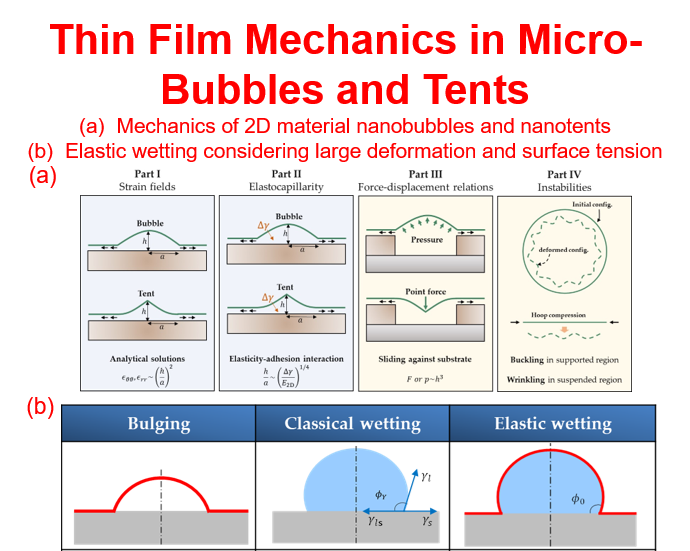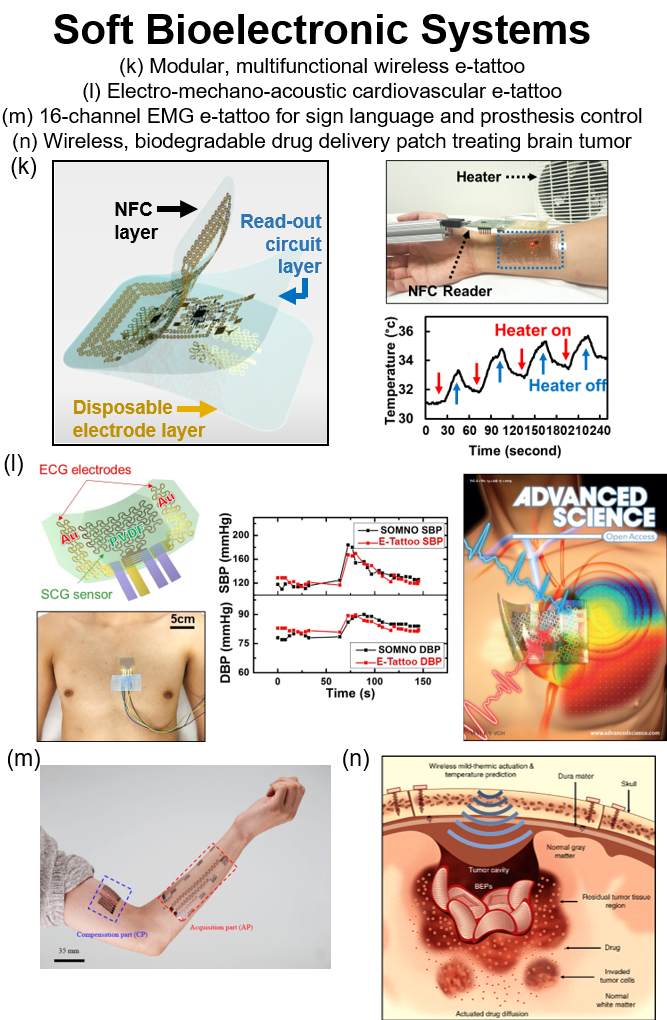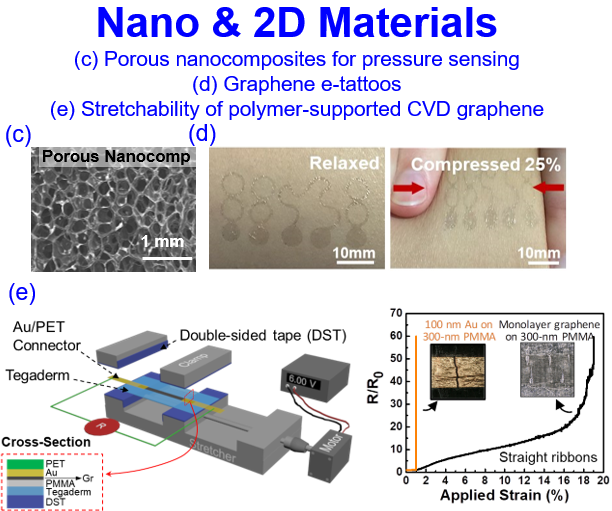- Mechanics of micro-bubbles and tents
Flexible and stretchable electronics make use of all kinds of thin films including metallic, ceramic, polymeric membranes and even atomically thin solids called 2D materials. Poking and bulging are widely used setups for characterizing the mechanical and interfacial properties of thin films. We call the poked and bulged thin solids to be tents and bubbles (a-b), respectively. Although classical elasticity solutions are available for macroscale poking and bulging problems, the boundary condition has been largely limited to clamped edges and the electrocapillary effects are too trivial to be considered. At microscale, however, the behaviors of the bubbles and tents are governed by the interplay of nonlinear elasticity, surface and interface effects, as well as instabilities. As a result, my group has carried out a series of in-depth mechanics modeling works along with a few experimental validations to have successfully answered the following important questions: 1) How do surface and interface energies dictate the geometry of the bubbles?1,2 2) How does the edge slippage modify the mechanical responses of the tents and the bubbles?3 3) How do the radial buckle delaminations form and what are their indications?4 4) How would those effects modify the load-deflection or the p–V curves?2,5 These fundamental understandings have led to a few significant impacts: 1) They provide guidance for the deterministic formation of micro-bubbles and tents. 2) They offer a direct solution to the pressure, force, and strain in micro-bubbles and tents simply out of their geometry. 3) They allow reliable extraction of the elastic and interfacial properties of 2D materials and ultrathin polymeric membranes which are otherwise difficult to handle and measure. We have also published three well-received invited review papers on 2D material mechanics.6,7,8
- Nano & 2D Materials
My group has engineered nano and 2D materials into soft sensors. One example is a porous nanocomposite as the functional material for wide-range, high-sensitivity capacitive pressure sensors (c) (manuscript is under revision with Adv. Mater.). Another example is the world’s first submicron-thick e-tattoo based on large-area monolayer graphene grown through chemical vapor deposition (CVD) (d) 9,10. It has been applied as ultra-conformable and hence low-contact-impedance dry electrodes for high-fidelity, long-term electrophysiological sensing.9 It has also been used as a mechanically and optically imperceptible electrooculography (EOG) sensor placed on human face for the remote control of a drome purely through eyeball rotation.10 Our groundbreaking work of ultra-conformable graphene e-tattoo (GET) has sparked numerous developments of skin-conformable electrodes based on gold nanomesh and other 2D materials. We have carefully characterized the stretchability of CVD monolayer graphene supported by ultrathin polymer substrate and found that it has much better mechanical robustness than nanocrystalline gold thin films (e).11 In collaboration with Prof. Edward Yu at UT, we have also investigated the piezoelectric and flexoelectric properties of 2D materials using piezoresponse force microscopy (PFM) 12,13.
- Manufacture & Transfer
The conventional fabrication method for stretchable electronics is labor and cost intensive, which significantly hinders their translation from lab prototypes to clinical use. To overcome such limitations, my group developed a dry and freeform (subtractive) manufacturing process for the rapid prototyping of stretchable e-tattoos called the “cut-and-paste” method in 2015.14 In 2019, we upgraded it to the “cut-solder-paste” process (f) which allows the incorporation of rigid integrated circuits (ICs) such as microprocessors and near field communication (NFC) chips to form wireless e-tattoos (e.g. k).15 We reported that multi-channel, large-area but ultrathin, filamentary e-tattoos could be reliably pasted onto non-developable human body through a math concept called the Cartan development (g).16 Such e-tattoo conformed to the forearm as shown in (m) could conduct 16-channel surface electromyography (sEMG), which can be used for sign language recognition and prosthesis control.
- Bio-Electronics Interface
To enable reliable but reversible bio-electronics interface adhesion, my group has conducted theoretical, numerical and experimental investigations on an emerging class of dry adhesives with surface craters in both ambient and underwater environment (h).17,18,19,20,21,22 This series of work has been summarized in an invited review paper.23 Sometimes conformability has to be achieved between stiff (due to high-device-density) membranes and non-developable surfaces such as the example of the artificial antenna (i).24 In this case, cuts inspired by kirigami were used to minimize buckle delamination and enhance conformability. Conformable contact affords effective heat transfer at the bio-e interface, which has been modeled in finite element (j) and the model was used to guide the design of the wireless brain patch for tumor treatment (n).25
- Soft Bioelectronics Systems
With the knowledge we learned and created in mechanics, materials, manufacture and bio-e interface, my group has built a few soft bioelectronic systems on our own (k-m)15,16,26 and in collaboration (e.g., n).24,25,27,28,29, Specifically, the modular wireless e-tattoo made through the “cut-solder-paste” method could be disassembled and reconfigured into e-tattoos of different sensing modalities because they all share a generic NFC layer (k). We also had a cover article on Adv. Sci. reporting a dual-mode e-tattoo that could simultaneously measure one’s electrocardiogram (ECG) and seismocardiogram (SCG), out of which cardiac time intervals and ultimately one’s blood pressure could be extracted beat-by-beat (l).26 The SCG sensing was achieved through am ultrathin stretchable sensor made out of piezoelectric polyvinylidene fluoride (PVDF) which was designed based on our mechanics knowledge of piezoelectric serpentines.30
1 Sanchez, D.A., Dai, Z., Wang, P., Cantu-Chavez, A., Brennan, C.J., Huang, R., and Lu, N.: ‘Mechanics of spontaneously formed nanoblisters trapped by transferred 2D crystals’, Proceedings of the National Academy of Sciences, 2018, 115, (31), pp. 7884-7889
2 Rao, Y., Qiao, S., Dai, Z., and Lu, N.: ‘Elastic Wetting: Substrate-Supported Droplets Confined by Ultrathin Elastic Membranes’, J Mech Phys Solids, 2021, 151, pp. 104399
3 Dai, Z., Hou, Y., Sanchez, D.A., Wang, G., Brennan, C.J., Zhang, Z., Liu, L., and Lu, N.: ‘Interface-Governed Deformation of Nanobubbles and Nanotents Formed by Two-Dimensional Materials’, Physics Review Letters, 2018, 121, (26), pp. 266101
4 Dai, Z., Sanchez, D.A., Brennan, C.J., and Lu, N.: ‘Radial Buckle Delamination around 2D Material Tents’, J Mech Phys Solids, 2020, 137, pp. 103843
5 Dai, Z., and Lu, N.: ‘Poking and bulging of suspended thin sheets: Slippage, instabilities, and metrology’, J Mech Phys Solids, 2021, 149, pp. 104320
6 Akinwande, D., Brennan, C.J., Bunch, J.S., Egberts, P., Felts, J.R., Gao, H., Huang, R., Kim, J.-S., Li, T., Li, Y., Liechti, K.M., Lu, N., Park, H.S., Reed, E.J., Wang, P., Yakobson, B.I., Zhang, T., Zhang, Y.-W., Zhou, Y., and Zhu, Y.: ‘A review on mechanics and mechanical properties of 2D materials—Graphene and beyond’, Extreme Mechanics Letters, 2017, 13, pp. 42-77
7 Dai, Z., Lu, N., Liechti, K.M., and Huang, R.: ‘Mechanics at the interfaces of 2D materials: Challenges and opportunities’, Current Opinion in Solid State and Materials Science, 2020, 24, (4), pp. 100837
8 Sanchez, D.A., Dai, Z., and Lu, N.: ‘2D Material Bubbles: Fabrication, Characterization, and Applications’, Trends in Chemistry, 2021, 3, (3), pp. 204-217
9 Ameri, S.K., Ho, R., Jang, H.W., Tao, L., Wang, Y.H., Wang, L., Schnyer, D.M., Akinwande, D., and Lu, N.: ‘Graphene Electronic Tattoo Sensors’, Acs Nano, 2017, 11, (8), pp. 7634-7641
10 Ameri, S.K., Kim, M., Kuang, I.A., Perera, W.K., Alshiekh, M., Jeong, H., Topcu, U., Akinwande, D., and Lu, N.: ‘Imperceptible Electrooculography Graphene Sensor System for Human-Robot Interface ’, npj 2D Materials and Applications, 2018, 2, pp. 19
11 Jang, H., Dai, Z., Ha, K.-H., Ameri, S.K., and Lu, N.: ‘Stretchability of PMMA-supported CVD graphene and of its electrical contacts’, Semiconduct Semimet, 2019, 7, (1)
12 Brennan, C.J., Ghosh, R., Koul, K., Banerjee, S.K., Lu, N.S., and Yu, E.T.: ‘Out-of-Plane Electromechanical Response of Monolayer Molybdenum Disulfide Measured by Piezoresponse Force Microscopy’, Nano Lett, 2017, 17, (9), pp. 5464-5471
13 Brennan, C.J., Koul, K., Lu, N., and Yu, E.T.: ‘Out-of-Plane Electromechanical Coupling in Transition Metal Dichalcogenides ’, Appl Phys Lett, 2020, 116, pp. 053101
14 Yang, S., Chen, Y.C., Nicolini, L., Pasupathy, P., Sacks, J., Becky, S., Yang, R., Daniel, S., Chang, Y.F., Wang, P., Schnyer, D., Neikirk, D., and Lu, N.: ‘”Cut-and-Paste” Manufacture of Multiparametric Epidermal Sensor Systems’, Adv Mater, 2015, 27, (41), pp. 6423–6430
15 Jeong, H., Wang, L., Ha, T., Mitbander, R., Yang, X., Dai, Z., Qiao, S., Shen, L., Sun, N., and Lu, N.: ‘Modular and Reconfigurable NFC-Enabled Wireless Electronic Tattoos for Biometric Sensing’, Advanced Materials Technologies, 2019, pp. 1900117
16 Wang, Y., Yin, L., Bai, Y., Liu, S., Zhou, Y., Wang, L., Hou, C., Yang, Z., Wu, H., Ma, J., Shen, Y., Deng, P., Zhang, S., Duan, T., Li, Z., Ren, J., Xiao, L., Yin, Z., Lu, N., and Huang, H.: ‘Electrically compensated, tattoo-like electrodes for epidermal electrophysiology at scale’, Sci Adv, 2020, 6, pp. eabd0996
17 Qiao, S.T., Wang, L., Jeong, H.Y., Rodin, G.J., and Lu, N.S.: ‘Suction effects in cratered surfaces’, J R Soc Interface, 2017, 14, (135), pp. 20170377
18 Wang, L., Qiao, S.T., and Lu, N.S.: ‘Effects of surface tension on the suction forces generated by miniature craters’, Extreme Mechanics Letters, 2017, 15, pp. 130-138
19 Qiao, S.T., Wang, L., Ha, K.H., and Lu, N.S.: ‘Suction effects of craters under water’, Soft Matter, 2018, 14, (42), pp. 8509-8520
20 Wang, L., Ha, K., Qiao, S., and Lu, N.: ‘Suction Effects of Crater Arrays’, Extreme Mechanics Letters, 2019, submitted
21 Lu, N.: ‘Reversible Dry Adhesives’, Soft Robotics, 2016, 3, (3), pp. 99-100
22 Choi, M.K., Park, O.K., Choi, C., Qiao, S., Ghaffari, R., Kim, J., Lee, D.J., Kim, M., Hyun, W., Kim, S.J., Hwang, H.J., Kwon, S.-H., Hyeon, T., Lu, N., and Kim, D.-H.: ‘Cephalopod-Inspired Miniaturized Suction Cups for Smart Medical Skin’, Adv Healthc Mater, 2015, 5, (1), pp. 80-87
23 Wang, L., Ha, K.-H., Rodin, G.J., Liechti, K.M., and Lu, N.: ‘Mechanics of Crater-Enabled Soft Dry Adhesives: A Review’, Frontiers in Mechanical Engineering | Tribology, 2020, 6, pp. 601510
24 Choi, C., Choi, M.K., Liu, S.Y., Kim, M.S., Park, O.K., Im, C., Kim, J., Qin, X.L., Lee, G.J., Cho, K.W., Kim, M., Joh, E., Lee, J., Son, D., Kwon, S.H., Jeon, N.L., Song, Y.M., Lu, N.S., and Kim, D.H.: ‘Human eye-inspired soft optoelectronic device using high-density MoS2-graphene curved image sensor array’, Nat Commun, 2017, 8, pp. 1664
25 Lee, J., Cho, H.R., Cha, G.D., Seo, H., Lee, S., Park, C.K., Kim, J.W., Qiao, S.T., Wang, L., Kang, D., Kang, T., Ichikawa, T., Kim, J., Lee, H., Lee, W., Kim, S., Lee, S.T., Lu, N.S., Hyeon, T., Choi, S.H., and Kim, D.H.: ‘Flexible, sticky, and biodegradable wireless device for drug delivery to brain tumors’, Nat Commun, 2019, 10
26 Ha, T., Tran, J., Liu, S., Jang, H., Jeong, H., Mitbander, R., Huh, H., Qiu, Y., Duong, J., Wang, R.L., Wang, P., Tandon, A., Sirohi, J., and Lu, N.: ‘A chest-laminated ultrathin and stretchable e-tattoo for the measurement of electrocardiogram, seismocardiogram, and cardiac time intervals’, Adv Sci, 2019, pp. 1900290
27 Park, J., Choi, S., Janardhan, A.H., Lee, S.Y., Raut, S., Soares, J., Shin, K., Yang, S.X., Lee, C., Kang, K.W., Cho, H.R., Kim, S.J., Seo, P., Hyun, W., Jung, S., Lee, H.J., Lee, N., Choi, S.H., Sacks, M., Lu, N.S., Josephson, M.E., Hyeon, T., Kim, D.H., and Hwang, H.J.: ‘Electromechanical cardioplasty using a wrapped elasto-conductive epicardial mesh’, Sci Transl Med, 2016, 8, (344)
28 Song, J.K., Son, D., Kim, J., Yoo, Y.J., Lee, G.J., Wang, L., Choi, M.K., Yang, J., Lee, M., Do, K., Koo, J.H., Lu, N.S., Kim, J.H., Hyeon, T., Song, Y.M., and Kim, D.H.: ‘Wearable Force Touch Sensor Array Using a Flexible and Transparent Electrode’, Adv Funct Mater, 2017, 27, (6)
29 Kim, M.K., Parasuraman, R.N., Wang, L., Park, Y., Kim, B., Lee, S.J., Lu, N., Min, B.C., and Lee, C.H.: ‘Soft-packaged sensory glove system for human-like natural interaction and control of prosthetic hands’, Npg Asia Mater, 2019, 11, pp. 43
30 Liu, S., Ha, T., and Lu, N.: ‘Experimentally and Numerically Validated Analytical Solutions to Nonbuckling Piezoelectric Serpentine Ribbons’, Journal of Applied Mechanics, 2019, 86, (5), pp. 051010











